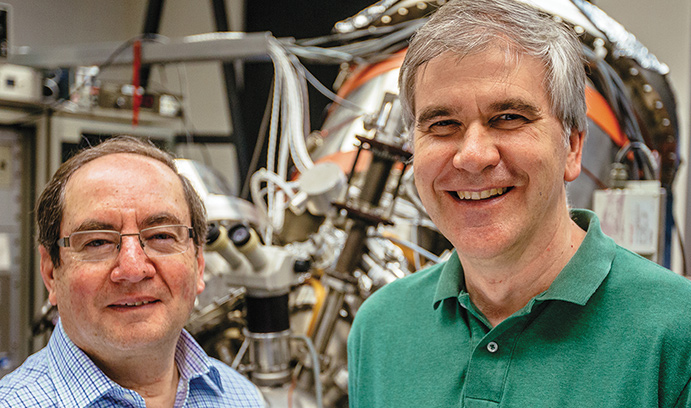Opening Up Possibilities for Greener Natural Gas

Israel E. Wachs, left, and Christopher Kiely
Two professors renowned for their work in catalysis have made discoveries that could accelerate the push for greener and more efficient fuel sources.
Israel E. Wachs and his colleagues have achieved a molecular-level understanding of a catalytic reaction that directly converts natural gas into valuable liquid fuels and feedstocks for the chemical industry. The researchers showed that the activity of a molybdenum catalyst can be enhanced and restored.
Christopher Kiely and his colleagues have verified the superior performance of a nanoscale alloy catalyst in bringing about a key reaction in the processing of biomass into fuels, plastics and other renewable products.
Wachs, the G. Whitney Snyder Professor of Chemical and Biomolecular Engineering, collaborated with researchers from the Stevens Institute of Technology in New Jersey. The group reported their results in April in Science.
Kiely, the Harold B. Chambers Senior Professor of Materials Science and Engineering, worked with researchers from Utrecht University in the Netherlands and University College London in the United Kingdom. The researchers reported their findings in the March 17 edition of Nature Communications.
In their research, Wachs and Prof. Simon Podkolzin of Stevens Institute and their students combined state-of-the-art spectroscopy techniques, reaction rate measurements and quantum-chemical calculations.
The rapid deactivation of the molybdenum catalyst has been one of the biggest obstacles to its commercial use in the liquefaction of natural gas. Wachs and Podkolzin demonstrated that this deactivation can be reversed and catalytic activity fully restored. They also showed that the distribution of the molybdenum nanostructures can be controlled, enhancing catalytic activity.
This improvement could make it easier to process natural gas into liquid fuels and chemical feedstocks, the researchers say, and could help reduce the more than 140 billion cubic meters of natural gas that are discharged each year into the atmosphere, often at remote oil wells where shipment of natural gas is not feasible.
The other coauthors of the Science article were Jie Gao and Yiteng Zheng of Stevens Institute and Yadan Tang and Jih-Mirn Jehng of Lehigh. Tang completed her Ph.D. at Lehigh in 2014. Jehng is a former visiting scientist.
Kiely’s collaborators at Utrecht used a modified impregnation technique previously developed by Kiely and researchers from Cardiff University in the UK to fashion a catalyst of nanoparticles containing ruthenium and palladium on a titanium dioxide support. Using Lehigh’s world-class electron microscopy facilities, Qian He ’12 Ph.D., a coauthor of the article now with Oak Ridge National Laboratory, imaged and chemically analyzed the Ru-Pd nanoparticles.
Biomass is composed mostly of cellulose. During processing, cellulose is degraded into levulinic acid (LA) and then hydrogenated into gamma-Valerolactone (GVL), a chemical building block that can be converted into fuels, solvents, plastics and perfumes. The Ru-Pd catalyst developed by the Utrecht group, says Kiely, converts LA into GVL much more efficiently than other metal catalysts.
“Many value-added products can in turn be obtained from LA,” the Utrecht group wrote in Nature Communications, “including polymer monomers, solvents, plasticizers and fuel components and their precursors. Many of these routes actually involve GVL…as intermediate, making the hydrogenation of LA to GVL a reaction of immense importance.”
Biomass can be generated from plants that re-grow and have few competing uses. These include switchgrass and other non-edible plants, corn husks and straw, forest foliage, lawn clippings, tree trimmings and some fast-growing trees.
“We currently get a lot of building blocks from petroleum,” says Kiely. “But there’s a finite supply of oil. We can regrow biomass.”
The lead author on the Nature Communications paper is Wenhao Luo of Utrecht. The other authors, in addition to Kiely and He, are Sankar Meenakshisundaram, Pieter Bruijnincx and Bert Weckhuysen of Utrecht, and Andrew Beale of University College.
Posted on:

